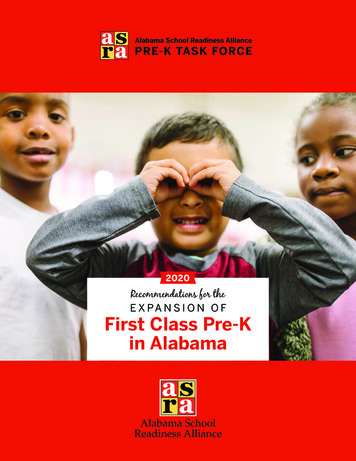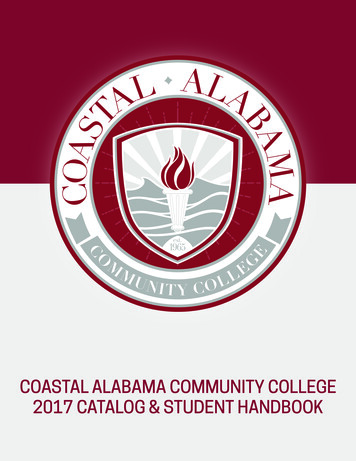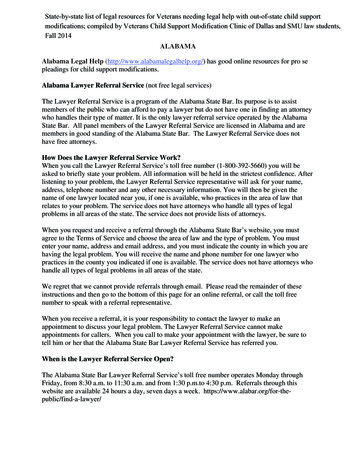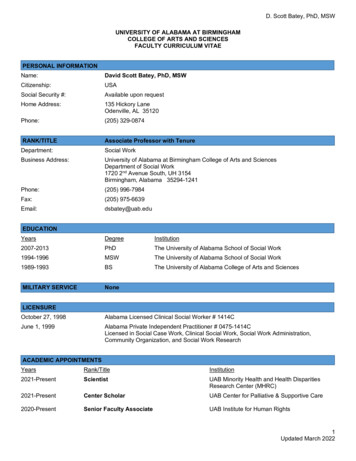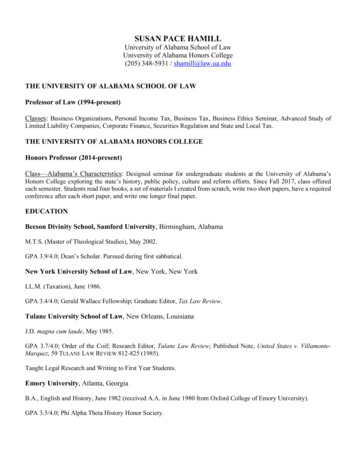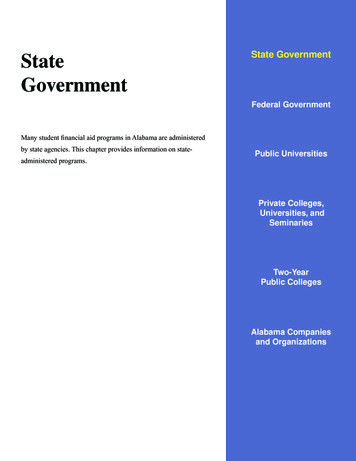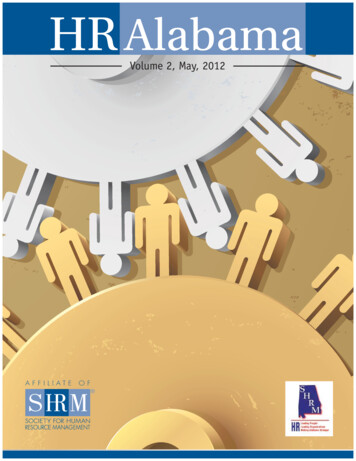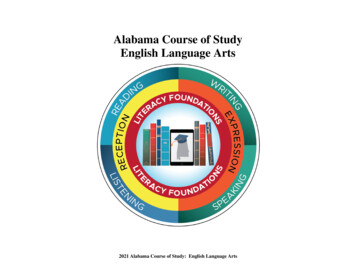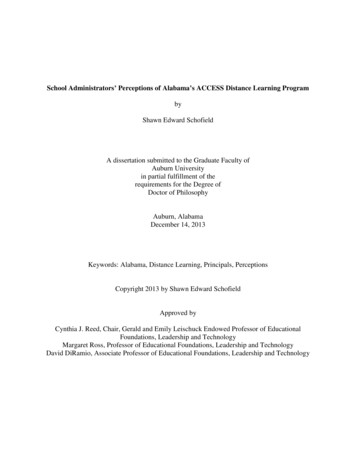
Transcription
School Administrators’ Perceptions of Alabama’s ACCESS Distance Learning ProgrambyShawn Edward SchofieldA dissertation submitted to the Graduate Faculty ofAuburn Universityin partial fulfillment of therequirements for the Degree ofDoctor of PhilosophyAuburn, AlabamaDecember 14, 2013Keywords: Alabama, Distance Learning, Principals, PerceptionsCopyright 2013 by Shawn Edward SchofieldApproved byCynthia J. Reed, Chair, Gerald and Emily Leischuck Endowed Professor of EducationalFoundations, Leadership and TechnologyMargaret Ross, Professor of Educational Foundations, Leadership and TechnologyDavid DiRamio, Associate Professor of Educational Foundations, Leadership and Technology
AbstractThe purpose of this study was to examine Alabama high school principals’ perceptionsabout ACCESS Distance Learning. An exploratory research design was used and data werecollected by survey. The survey was emailed to 508 Alabama high school principalsrepresenting the 132 school districts statewide (as of 2013). Fifty-two surveys were completed,returned, and analyzed, yielding a 10% return rate. Demographic information was collected andused as variables when analyzing other data. Quantitative survey responses were analyzed usingmeans, standard deviations, frequencies, percentages, and Pearson’s r. Findings reveal that therewas no statistical significance between principal demographics and the variables of student levelof learning and instructional processes. However, results indicated that there is a positivecorrelation between the variables of instructional processes and levels of learning. Findingssuggest the majority of principals participating in this study are supportive of ACCESS inrelation to course preparedness, the learning environment, assessment procedures, high qualityinstruction, its personnel, and its logistics. However, they perceive that student motivation,sufficient student feedback, level of student interaction, and instructional delivery that meetsstudents’ needs are concerns. Additionally, when asked about whether or not ACCESS providesequal to or better than face-to-face instruction, principals favored face-to-face instruction (N 35,67.2%). This is troubling, since ACCESS received high praise from students and teachers in fiveexternal reviews (Roblyer, Bielefeldt & Olszewski, 2010; Roblyer, Bielefeld, Sampson-Gruener& 2009; Roblyer, Freeman, Stabler, & Schneidmiller, 2007a, 2007b, 2008). ACCESSii
policymakers should consider the feedback and expertise of principals who are directlyresponsible for the success of their students when making policy decisions in the future.iii
AcknowledgmentsI would like to acknowledge Almighty God. Without him, none of this would have beenpossible. I would like to thank my wife Vera, who inspired me to be a better man, a betterhusband, a better father, and a better leader. To my kids, Amanda and Tommy, I thank you forbeing patient with your dad and for being great kids. Thank you for believing in me. To JeffRowell, one of my best friends, thank you for making me realize that through faith, all things arepossible. There were many times when I wanted to quit, but my faith, my family, and my friendsencouraged me to never give up. To my Committee Chair, Dr. Cynthia Reed, to Dr. MargaretRoss, to Dr. David DiRamio, and to my outside reader, Dr. Bill Sauser, I say thank you for thehard work you expended towards my successful journey. Without you all, I would never havefinished this work. I am forever indebted to you all.iv
Table of ContentsAbstract . iiAcknowledgments. ivList of Tables . xList of Figures . xiiCHAPTER ONE. INTRODUCTION . 1Background of the Study . 2ACCESS as a Bridge to Rural and Underserved Students . 6ACCESS Expands Course Offerings . 6Equal Opportunity. 7Use of Multimedia and Technology . 7Commitment to ACCESS . 8Quality Teachers, Technology, and Facilitators . 9Outside Evaluator. 9Transformational Instruction . 10Conceptual Framework . 12Problem Statement . 15Purpose of the Study . 16Research Questions . 17Research Methods . 18v
Significance of the Study . 18Assumptions of the Study . 18Research Limitations . 19Definition of Terms. 19Organization of the Study . 22CHAPTER TWO. REVIEW OF THE LITERATURE . 23Introduction . 23Advent of Distance Learning and Online Learning . 24No Child Left Behind, Adequate Yearly Progress, and Online Learning . 24ACCESS in Alabama . 26Leadership in ACCESS. 27Blended Learning . 28ACCESS Implementation at the Local Level . 29External Evaluation . 30ISTE’s Evaluation Findings . 31Future Policy Considerations and ACCESS . 31High School Principals as Influential Leaders . 33Effective Leadership . 35Principal Technology Acumen . 37Technology Standards for School Administrators . 38Technology Leadership . 39Summary . 42vi
CHAPTER THREE. METHODS . 44Research Questions . 44Instrument . 45Validity and Reliability . 46Content Validity . 46Reliability. 47Participants . 47Procedures . 47Data Source . 48Data Analysis . 49Summary . 49CHAPTER FOUR. RESULTS . 50Participants . 51Results . 55Perceptions of Alabama High School Principals Regarding InstructionalProcesses of Distance Learning Courses . 56Distribution of Administrators’ Perceptions of Adequate Motivation forStudent Learning in ACCESS Courses . 56Distribution of Administrators’ Perceptions of Instructional Delivery ofAppropriate Subject-Level Knowledge in ACCESS Courses . 57Distribution of Administrators’ Perceptions ofSufficient Student Interaction . 58Distribution of Administrators' Perceptions ofSufficient Feedback to Students. 59Distribution of Administrators’ Perceptions of How Instruction andDelivery Provide a Respectful Learning Environment for Students . 60vii
Distribution of Administrators’ Perceptions of How Instruction andDelivery Meets Students’ Needs . 60Distribution of Perceptions of How Instruction and Delivery of DistanceEducation Courses Offer Appropriate Proceduresand Processes for Assessment . 61Distribution of Perceptions of How Instruction and Delivery of DistanceEducation Courses Offer Appropriate Grading Processes . 62Distribution of Administrators’ Perceptions of How Instruction andDelivery of Distance Education Courses Offered Through ACCESSProvides High Quality Instruction . 63Distribution of Administrators’ Perceptions Regarding LearningOutcomes Equal To or Better Than Face-To-Face Courses . 63Differences in Perceptions of Instructional Processes Based on Demographics 64Relationship between Level of Learning and Regional In-Service Centers . 65Perceptions of Alabama High School Principals Regarding the Levelof Learning in ACCESS Distance Learning Courses . 66Differences in Perceptions Regarding Level of Learning Based onDemographics . 68Relationship Between Perceptions of the Instructional Processes andLevel of Learning . 70Purposes and Factors for the Selection of Distance Learning Courses . 71Summary . 73CHAPTER FIVE. CONCLUSIONS, LIMITATIONS, AND FUTURE RESEARCH. 75Introduction . 75Review of Methodology . 76Demographic Characteristics of ACCESS Schools and Their Principals . 78Demographic Findings . 78Perceptions of Instructional Processes and Student Learning . 79viii
Perceptions of Instructional Processes, School Size, Years of Experience,and Regional In-service Center . 80Perceptions of the Level of Student Learning in ACCESSDistance Learning Courses . 80Perceptions on Level of Student Learning Based on Demographics . 80Perceptions of the Instructional Processes and Level of Student Learning . 81Criteria Used by Alabama High School Principals to EvaluateACCESS Courses. 81Discussion . 81Implications. 84Recommendations for Future Research . 86Summary . 87References . 89Appendix A. Recruitment Letter, Information Email . 103Appendix B. Approval to Use Survey . 110Appendix C. Survey Instrument . 111Appendix D. Auburn University Institutional Review Board (IRB) Approval . 117ix
List of TablesTable 1Distribution of Participants by School Size . 53Table 2Distribution of Participants by Regional In-Service Center . 53Table 3Distribution of Participants by Years of Administrative Experience . 54Table 4Gender of Participants. 54Table 5How Participants Use Technology in Their Personal and Professional Lives. 55Table 6Distribution of Administrators’ Perceptions about Levels of Preparednessand Organization in ACCESS Courses . 56Table 7Distribution of Administrators’ Perceptions about Adequate Motivation inACCESS Courses. 57Table 8Distribution of Administrators’ Perceptions of Instructional Delivery ofAppropriate Subject-Level Knowledge in ACCESS Courses . 58Table 9Distribution of Administrators’ Perceptions of Sufficient Student Interaction . 59Table 10 Distribution of Administrators’ Perceptions of Sufficient Feedback to Students. 59Table 11 Distribution of Administrators’ Perceptions of a Respectful LearningEnvironment for Students . 60Table 12 Distribution of Administrators’ Perceptions of How Instruction and DeliveryMeets Students’ Needs . 61Table 13 Distribution of Administrators’ Perceptions of How Instruction and Delivery ofDistance Education Courses Provided Appropriate Procedures and Processes forAssessment . 62Table 14 Distribution of Perceptions of How Instruction and Delivery of DistanceEducation Courses Offer Appropriate Grading Processes . 62x
Table 15 Frequency Distribution of How Instruction and Delivery of ACCESS CoursesProvides High Quality Instruction . 63Table 16 Distribution of Administrators’ Perceptions Regarding Learning OutcomesEqual To or Better Than Face-To-Face Courses . 64Table 17 Correlations Between Instructional Processes, School Size andAdministrative Experience. 65Table 18 Mean Level of Learning Scores as a Function of Regional Inservice Center(with Standard Deviations in Parentheses) . 66Table 19 Distribution of Administrators’ Perceptions of the How Often ACCESSClasses Align to Current Content Standards . 67Table 20 Distribution of Administrators’ Perceptions of How Well ACCESSCourses Prepare Students for Future High School Courses . 67Table 21 Distribution of Administrators’ Perceptions of How Often Instruction andDelivery of Distance Education Courses Offered Through ACCESSPrepare Students for College Entrance Exams such as ACT or SAT Test . 68Table 22 Distribution of Administrators’ Perceptions of How Often Instruction andDelivery of Distance Education Courses Offered Through ACCESSMeet the Expected Learning Outcomes . 68Table 23 Correlations Between Years of Administrative Experience, School Size,and Level of Learning . 69Table 24 Correlations between Instructional Processes and Level of Learning . 70Table 25 Frequency Distribution of Purposes for Course Selection . 71Table 26 Factors for Course Selection . 72xi
List of FiguresFigure 1. The Impact of Instructional Processes, Levels of Student Learning, andLeadership Theories on Principals’ Perceptions of ACCESS. . 73xii
CHAPTER ONE. INTRODUCTIONThis research study examines the perceptions of Alabama high school principals aboutdistance learning, with respect to instructional processes and levels of student learning. Thischapter provides a brief synopsis of background information related to the study, situates thestudy purpose within relevant literature, briefly describes the methods used to explore the topicand the significance of the research, and offers explanation of the underlying assumptions,limitations, and definitions pertinent to the study.Background of the StudyInternet-based distance education has caused an important paradigm shift in America’seducational system (Levy, 2003). Across the state of Alabama, distance learning has been seenas a key strategy to address educational inequities, while offering a powerful tool to improveaccess to quality education, particularly in rural communities (Roblyer, Freeman, Stabler, &Schneidmiller, 2007a). In the past, schools in the most remote areas have had extensivedifficulty recruiting and retaining qualified teachers who have the appropriate subject matterexpertise and credentials, thus making it difficult for these schools and districts to offer a fullrange of course options (Crocker, 1989; Crocker & Riggs, 1979; House, 1986; Riggs, 1987).Distance learning may offer an alternative to these inequities, while enhancing instructionalquality (Roblyer et al., 2007a).The Alabama Connecting Classrooms, Educators, and Students Statewide (ACCESS)program was created to deliver instruction to rural and low-income students in Alabama who1
have limited course offerings for students (Roblyer, Freeman, Donaldson, & Maddox, 2007).The ACCESS Distance Learning Initiative was launched on November 1, 2004, with funding of 10.3 million starting October 1, 2005 (Roblyer, Freeman, Stabler, & Schneidmiller, 2007a).The distance education initiative was the culmination of research and planning by Governor BobRiley’s Task Force on Distance Learning.Alabama’s distance learning program is on the cutting edge of such a framework(Roblyer et al., 2007a). Current literature about ACCESS has shown that there appears to be nostatistically significant differences between students who attend classes through AsynchronousLearning versus Interactive Video Conferencing (Roblyer, Freeman, Donaldson, & Maddox,2007). Current literature about ACCESS also infers that teachers and students were reported asbeing “generally satisfied with the instructional strategies used in both IVC and online coursesand view them as beneficial to support learning” (Roblyer et al., 2007a). Notwithstanding, thereis a lack of research addressing the perceptions, attitudes, and contextual differences amongAlabama high school principals regarding the ACCESS program, particularly with respect to theinstructional processes involved and the levels of learning and academic success of their studentsin the program. This study explores the perceptions of Alabama high school principals and alsoexamines the relationships among demographic characteristics of Alabama high schools, such asschool size, location of the school district, and the number of years the principal has as a schooladministrator and principal views on ACCESS.Distance learning, since its inception, has been and will likely continue to be a form ofinstructional delivery that may rescue students in times of need and provide them with anadditional opportunity to excel. The expansion of distance learning in America’s high schoolshas become commonplace, and oftentimes this has been out of necessity (Cavanaugh, Barbour,2
& Clark, 2009). Virtual schools and distance learning educational settings are eitherasynchronous online (Internet web-based or computer-based learning with no teacher present), orsynchronous (videoconferencing, classroom lectures, and online chat rooms) (Clark, 2001).Virtual schools and distance learning are seen as a solution to overcrowded schools, alack of qualified teachers, and to serve students who need to learn at a nontraditional pace orplace different from the school classroom (Cavanaugh & Clark, 2007). Consequently, virtualschools and distance learning programs have developed in many different ways, so as to meetstudents’ needs. Clark (2001) indicated that there were different types of virtual schools, basedon funding and governance, which he categorized into seven ways: State-sanctioned, state level schools College and university-based Consortium and regionally-based Local education agency-based Virtual charter schools Private rural schools For-profit providers of curricula, content, tools and infrastructureVirtual schools may be ideally suited to meet the needs of stakeholders who are callingfor school choice, high school reform, and workforce preparation in 21st century skills(Cavanaugh, Gillan, Kromrey, Hess, & Blomeyer, 2004). Barbour and Reeves (2009) haveclassified virtual schooling benefits could be divided into the following areas: expanding educational access providing high quality learning opportunities improving student outcomes and skills, allowing for educational choice3
achieving administrative efficiencyAccording to Cavanaugh et al. (2004), the many thousands of K–12 students whoparticipate in online education programs are attracted to virtual schooling because it offersadvantages over classroom-based programs. Among the benefits of distance education forschool-age children are increases in enrollment or time in school as education programs reachunderserved regions, broader educational opportunity for students who are unable to attendtraditional schools, access to resources and instructors not locally available, and increases instudent-teacher communication (Cavanaugh & Clark 2007; Moore & Kearsley, 2005).After the initial technological investment costs have been absorbed, school districts cangenerally assume costs associated with offering online courses with less financial burden becausethey do not have to hire a certified teacher for that course. In addition to being less expensive,students in virtual schools have shown to have improved student outcomes and skills (Berge &Clark, 2005; Zucker & Kozma, 2003). As distance education is currently practiced, educatorsand other stakeholders can reasonably expect learning in a well-designed distance educationenvironment to be equivalent to learning in a well-designed classroom environment (Cavanaugh,Gillan, Kromrey, Hess, & Blomeyer, 2004). Essentially, these advantages have been shown byresearchers to have more benefit than their traditional counterparts, assuming they have beenwell-designed (Bernard et al., 2004). In light of Bernard et al.’s research, Roblyer, Freeman,Donaldson, and Maddox (2007) found no significant differences in achievement when onlineenvironments were compared to Interactive Video Conferencing environments, which are nottraditional.Given the advantages posed here for incorporating distance learning into America’s highschools, distance learning is not for every student. Successful completion of distance education4
offerings requires students to be firmly ensconced in self-control, have self-directed focus, andintrinsic motivation (Cavanaugh, 2007; Kellog & Politoski, 2002). Learning any subject in sucha format has its own specific challenges, not least of which is the need to develop self-awarenessand acquire good self-management skills as part of developing autonomy as defined by Hurd etal. (2001) in their investigation of strategy instruction and learner support in relation to distancelanguage learning. They stress that conscious selection of strategies and self-directedinvolvement are characteristics of an autonomous approach, and particularly relevant to thoselearning in independent contexts (Hauck & Hurd, 2005).Distance learning is still an area with controversy. School leaders and researchers haveconflicting views about its effectiveness and benefits. Critics have found distance learningclasses to be ineffective, claiming that these classes almost always reflect higher student failureand dropout rates (Kozma & Zucker, 2003). This is a finding consistent with some researchersexamining postsecondary populations (Bernard et al., 2004). Additionally, these findings havealso been refuted (Cavanaugh, Gillan, Kromrey, Hess & Blomeyer, 2004; Kearsley, 2000).Several studies report no significant differences between K–12 distance education and traditionaleducation in relation to academic achievement (Falk et al., 1997; Goc Karp & Woods, 2003;Hinnant 1994; Jordan, 2002; Kozma et al., 2000; Mills, 2002; Ryan, 1996). The effectiveness ofdistance education appears to have more to do with who is teaching, who is learning, and howthat learning is accomplished, and less to do with the medium (Rice, 2006). As a result ofnegative criticism, states have been focused on designing and implementing distance learningenvironments that support their learners and show positive results (Rice, 2006).5
ACCESS as a Bridge to Rural and Underserved StudentsDistance learning in Alabama’s public schools is fast becoming a way towards bridgingrural and underserved students with more opportunities in their education (Maddox, 2008). Withthe advent of the Alabama Connecting Classrooms, Educators, & Students Statewide (ACCESS)initiative, teachers and students statewide use interactive videoconferencing as one avenue ofinstructional delivery. ACCESS is viewed by some as pivotal in its ability to offer studentsopportunities to take classes that are currently not available at their respective campuses(Maddox, 2008). ACCESS offers its students an instantaneous expansion of course offeringsthat have Alabama certified teachers (Roblyer et al., 2007a, 2007b, 2008; Roblyer, Bielefeldt, &Olszewski, 2010; Roblyer, Porter, Bielefeldt & Donaldson, 2009). With ACCESS, students canchoose to enroll in interactive videoconferencing classes (IVC), through asynchronous webbased coursework, or through both. According to the ACCESS website (Alabama StateDepartment of Education, 2011), ACCESS provides Alabama’s high school studen
The distance education initiative was the culmination of research and planning by Governor Bob Riley's Task Force on Distance Learning. Alabama's distance learning program is on the cutting edge of such a framework (Roblyer et al., 2007a). Current literature about ACCESS has shown that there appears to be no
